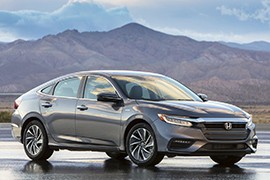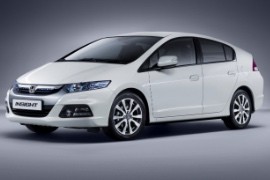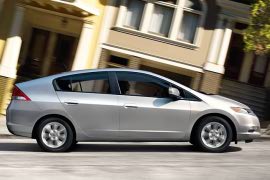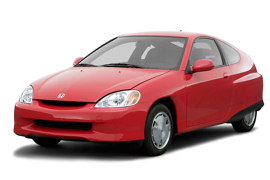HONDA Insight Models/Series Timeline, Specifications & Photos
First production year: 1999
Engines: Hybrid, Hybrid gasoline, Gasoline
Body style: Hatchback
While most of the hybrids available looked weird, the Honda Insight gave no apparent hint that it was a hybrid, aside for the badge at the rear.
More attractive than most of the sedans, the Insight sported design cues taken from the sibling Accord.
Based on a Civic platform, the sedan borrowed the roof and the rear quarter panels, while the rest was unique and specific to the Insight.
Inside, the quiet cabin was fitted with a standard active noise cancellation system. Even in the entry level, the Insight sported soft to touch materials and a 5-inch display, while the upper trim levels even featured fancy seats with perforated leather.
The top of the range had heated seats, and while extremely comfortable and suitable for long journeys, lumbar support adjustment was not available.
The roomy cabin offered great space for all occupants and was equipped with numerous large storage spaces. To enhance convenience, and USB and a wireless charging pad were part of the package.
Fitted with a 1.5-liter Atkinson-Cycle 4-cylinder engine, a lithium-ion battery pack and Honda’s two motor hybrid drive system, the Insight offered a reduced fuel consumption.
The available driving modes offered the possibility to cover up miles using only electricity, besides the Normal and the Sport mode which offered a quicker acceleration response.
Another great feature was the possibility of adjusting the regenerative braking intensity using the shift paddles mounted behind the steering wheel: left for more intense and right for less intense.
The cargo space was generous and with the batteries placed under the rear seats, they folded like normal seats, extending the trunk’s capacity.
The base trim level was very well equipped with numerous safety features part of the Honda Sensing: dynamic cruise control, lane keeping assist and forward collision warning with automatic braking.
Other features included automatic high beams, traffic sign recognition, a multi-angle back-up camera, remote engine start, blind spot camera and smart entry with walk away lock.
After escaping the world financial crisis with some models cut out from production, Honda managed to survive and introduced a facelifted version of the Insight lineup.
Honda introduced the second generation of the Insight Hybrid as a five-door hatchback in 2008 at the Paris Motor Show. Yet it didn't start deliveries until 2009 when customers were looking for fuel-efficient vehicles. The Insight was just like that, but, unfortunately, the car market crashed. Three years later, in 2012, the Japanese automaker introduced a well-deserved facelift for the car that managed to survive the world financial crisis. At the same time, the European Accord and the sporty CR-Z didn't.
On the new version, Honda introduced a blue line inside the headlights, emphasizing the carmaker's marketing strategy, "My Earth Dreams." Moreover, the grille was redesigned with a thicker upper slat than the previous three-slat layout. In addition, the lower bumper received LED daytime running lights and new fog lamps. Finally, at the back, the bumper got a new fog lamp integrated into the redesigned rear diffuser.
Inside, the most significant difference was for the infotainment unit that received a 16 Gb flash memory for the navigation system instead of the DVD-based sat-nav unit. Moreover, the materials' quality was enhanced. At the same time, the rear seats' arrangement was slightly modified, improving headroom. Finally, the carmaker added more sound-deadening materials. The 2009 model lacked most of them, and the car was very noisy at highway speeds, especially during rain.
Under the hood, besides the 1.3-liter-powered hybrid system, the 2012 model also received a 1.5-liter version that pumped up the power value from 98 to 122 hp. Thus, the time of 0-62 mph (0-100 kph) dropped from 12.4 to 10.3 seconds.
10 years later after revealing their first hybrid, Honda launched the new Insight in 2009. Many have said that the new Insight was much like the Toyota’s Prius, however, it was actually based on their first Insight, borrowing many of its characteristics.
The Insight had a futuristic and simple design, offering high visibility to the driver. It seems like the model was mostly thought for comfort, having a low driving position with extremely comfortable seats. The controls were simple, logical and intuitive.
Honda created a system to encourage the drivers to drive in an economical way. The Insight had an “eco” button that when pressed would guide the driver on how to drive in order to obtain a good score. Yes, you read it well, it actually gave the drivers a final score. The speed-o-meter was interactive, colored with blue and green. The blue color showed a polluting driving mode, blue and green – a relatively polluting driving mode and of course, green, the adequate way to drive.
The Insight was impressively safe, scoring 5 out of 5 at the Euro NCAP crash test. It was equipped with ABS, ESP, as well as driver, passenger, side and curtain airbags.
The Honda Insight was not very popular and it mostly attracted buyers who wanted to show a bit of empathy to the environment.
In 1999, Honda tried to launch a highly fuel-efficient vehicle with a gas-electric powerplant under the hood, but it was not a revolution.
Toyota got a better start with the Prius, which was launched in late 1997. Honda waited for another two years and introduced the first generation of the Insight in 1999. It was designed as a commuter car and advertised with a very optimistic fuel-efficiency. Its problem was that, in real life, a Civic was almost as economical as the Insight, but it offered four doors.
The soap-like coupe was intriguing and attracted a lot of attention to it when Honda introduced it on the North American market. Its tear-drop like headlights and futuristic look was unusual for those times. After the long hood, compared to the car's length, the raked windshield and the arched, short greenhouse made the vehicle looks like a toy. In the rear, the high mounted triangular taillights were very visible, and the introduction of a vertical glass panel on the liftgate greatly improved rear visibility.
Inside, the Insight featured a pair of bolstered seats at the front and a big shelf in the back, like a trunk. The part-digital, part-analog instrument cluster helped the driver get a smaller fuel consumption and constantly showed its efficiency.
Under the hood, the 1999 Insight featured a 3-cylinder gasoline engine and an electric motor. The assembly was paired to a 5-speed manual gearbox. Honda introduced a CVT in 2000.



